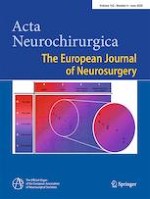Erschienen in:

04.04.2020 | Original Article - Vascular Neurosurgery - Aneurysm
Fusiform aneurysms of the vertebrobasilar complex: a single-center series
verfasst von:
Arthur Wagner, Sascha Prothmann, Dennis Hedderich, Silke Wunderlich, Bernhard Meyer, Jens Lehmberg, Maria Wostrack
Erschienen in:
Acta Neurochirurgica
|
Ausgabe 6/2020
Einloggen, um Zugang zu erhalten
Abstract
Background
Fusiform vertebrobasilar aneurysms (FVBAs) may exhibit a disastrous clinical course. Due to their rare occurrence, evidence concerning optimal management is lackluster.
Objective
To describe the epidemiology, clinical features and treatment outcomes of a consecutive series of patients admitted to our institution.
Methods
We retrospectively evaluated patient charts with respect to clinical presentation, treatment procedures, and the outcomes of all patients diagnosed with an FVBA, which were seen at our institution between March 2006 and February 2017.
Results
Forty-five consecutive patients were analyzed. Follow-up was available for 39 patients (86.7%) with a median duration of 28.8 months. Seventeen patients (37.7%) were asymptomatic, 14 patients (31.1%) presented with brainstem ischemia, 8 patients (17.8%) with supratentorial ischemia, and 3 (6.7%) patients with brain stem compression. Aneurysm rupture occurred in 3 patients upon presentation (6.7%). Initially, 19 patients (42.2%) were significantly disabled with Modified Rankin Scale (mRS) scores ≥ 3. Twelve patients (26.7%) underwent invasive treatment: endovascular therapy in 9 cases and surgical treatment in 3 cases. Thirty-three patients received conservative treatment. During follow-up, 6 events (66.7%) of severe disability or death (mRS 4–6) occurred in the endovascular group versus 1 event (33%) in the surgical group versus 19 events (63.3%) among conservatively treated aneurysms. Deterioration was significantly more frequent in patients with symptomatic aneurysms (p = 0.030).
Conclusion
Patients harboring an FVBA frequently present with disabling symptoms caused by various pathomechanisms. The natural history is aggressive, mostly for initially symptomatic aneurysms, and periprocedural morbidity of surgical or endovascular treatment remains substantial.